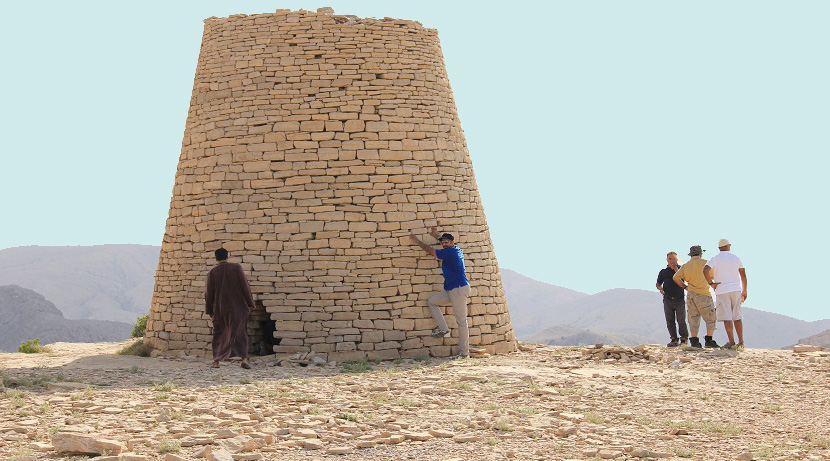

On the roads between Quriyat and Sur, is a piece of history that sits still on the area’s plateaus quietly watching over the Arabian sea. With the beautiful Hajjar mountains and the picturesque scenery of its surroundings as backdrop, a sign board guides tourists in the direction of the Kibaykib towers. Standing between 5 to 8 metres tall and approximately 4 metres in diameters, these structures were initially confused to be towers only to be discovered later from locals living in the area that these were in fact ancient remains of beehive tombs.
Accessibility is a slight problem for those not experienced with difficult terrains, Kibaykib towers also known as Jaylah Tower Tombs were discovered in the early 90s by archaeologist Paul Alan Yule after spotting these structures in the aerial photographs in the book by John Nowell, ‘A Day above Oman’. After this initial discovery, Dr Yule teamed up with Gerd Weisgerber to start documenting, mapping, excavating and working to restore at least of the tombs with the support and help of the German Omani Association in 1995.
Dating back to the bronze age, the Jaylah Tower Tombs are not what you’d expect in such a desolate place like Salmah Plateau. Over 90 tombs are spread out over a large area with many of these tombs being inaccessible. There are a number of different types of ancient tombs one can see here including the conical taller tombs to the others like the beehive tombs or commonly known as wolf traps along with other variations of these old tombs.
Dr. Yule and Weisgerber both tried their best but had difficulties pinpointing the exact age of these tombs for a variety of reasons, one being that the tombs had features that were not previously seen in other bronze age finds but also lacked many features that were prevalent in artefacts found from this time period.
As mentioned on the German Omani Association page and the article published by Dr Yule, Paul, and Gerd Weisgerber. Prehistoric Tower Tombs at Shir/Jaylah, Sultanate of Oman, it quotes, “Similar tombs are the “Nawamis” in the Sinai that are dated to the late Chalcolithic/Early Bronze Age (3500–2500 BC), as well as other tombs in the sultanate at Halban and Bat.”
What many along with scientists and historians find interesting is the condition of some of the still intact tombs. Unaffected by the thousands of years of wind, rain and sun many locals believe and fear that the jinn or “spirits” that live in the area are responsible for current good conditions of the tombs.
Locals share a strange story about the name Kibaykib claiming such a name is foreign to these regions. The story claims Kibaykib was the name of a Man who lived in the area and looked after and guarded the land around him. He was known to take money from those that trespassed and even built a house in the same area. It is said he died in Ibra but the story remains an Old wives’ tale with many variations floating amongst the locals.
Others believe that the village was built using these tomb stones and other believe it was used to build the other tombs, some are even convinced that Kibaykib was no man but a jinn himself!
According to the official source on the official website of the Amman Net of the Ministry of Information where he says: “In late 1991, a team of archaeologists, in cooperation with the Ministry of Heritage and Culture, conducted a survey and study of Bruges al-Jila in the site, and about 90 towers were discovered in good condition due to the durability of its construction. It is located at an altitude of 2000 m. 4 to 5 meters in diameter and 3 to 4 m, which is cylindrical Shape and round top of each of them consists of two walls filled with stones space located above the heights of mountains.
The mysteries around these 3000-year-old structures, about their construction, location or even the settlements during the assumed era all remain. But one thing is for sure, the tombs were built high up in the mountains for a reason, possibly to keep away from neighbouring attacks or wild animals but even more likely to give important people of prime burial, building tombs high enough so they were visible from far away settlements.
Many claims have been made about the life and death of Kibaykib and the reason behind these unique structures, the realirt of these Tombs or towers, no one can be sure off. The real story of these tombs remains buried along with the tales of Kibaykib himself.
Siham al saidi & Titash chakraborty
Oman Observer is now on the WhatsApp channel. Click here



